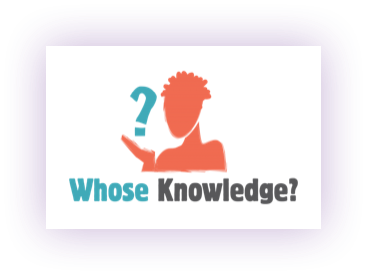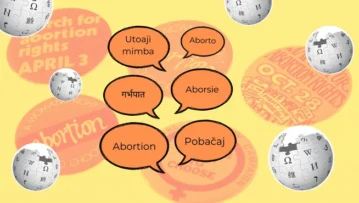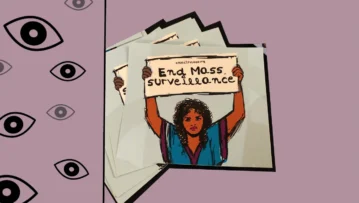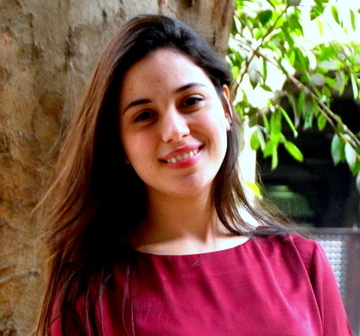How we began
In the last week of January 2018, we began a unique project. Mariana and I became the project coordinators for the #VisibleWikiWomen Challenge under the mentorship of the dedicated feminists from Whose Knowledge?: Siko, Anasuya, and Adele.
We were motivated by the fact that more than 80% of biographies of important women don’t have pictures on Wikipedia. The #VisibleWikiWomen campaign aims to change that. By coordinating with partners to upload photos of women to Wikimedia Commons, #VisibleWikiWomen makes more women visible online under Creative Commons and Public Domain licenses, including women from the global south.
We launched the challenge on 8 March – International Women’s Day – believing this was the best way to celebrate women from around the world: by making them more visible on Wikipedia. We started the challenge as a pilot to run through the month of March, a way to experiment and see if the idea was inspiring and the process useful. The goal from the outset was to upload only 100 pictures by the end of March. But by early April, we had added over 800 historical and contemporary public domain pictures of women to Wikimedia Commons! In the process we built connections with groups across the Wikimedia movement and beyond, who have been invaluable and inspiring partners throughout the process. The success of the project surprised and motivated us. By popular demand, we decided to extend the challenge into April and much of May!
#VisibleWikiWomen Stories: Remembering Marielle Franco
Over the course of the #VisibleWikiWomen Challenge, we were able to explore and reflect on the ways in which women are made (in)visible online. Many women aren’t deemed to have encyclopedic relevance during their lifetimes; they only become ‘visible’ when die. For instance, one of the women added to Wikimedia Commons as part of the #VisibleWikiWomen campaign is Marielle Franco, and we were proud to feature her powerful story, which is close to all our hearts.
Marielle wasn’t visible to most of the world until people made a social media buzz after her tragic assassination. Even on Wikipedia, an article written about her while she was still alive was deleted because she wasn’t considered notable enough to be profiled – until her death, when the article was re-posted and updated. Franco was an exceptional Brazilian black woman – a brilliant political activist, she always went the extra mile to advocate for what she believed in and to achieve personal and professional success against the odds. Marielle’s untimely death shed light on the increasing violence against women in Latin America and elsewhere. For instance, according to the Violence Map in Brazil, cited by the Inter Press Service, we know that after 2003, the murder of Black women has increased more than 50% while white women’s murders have decreased.
Marielle’s Wikipedia article and photograph became an invaluable resource for Brazilians and others, following her death. Her profile on Wikipedia (the 5th most visited website worldwide), had more than 70,000 views on the day after her assassination. The article on our website was translated into Arabic, English, French, Spanish, and Portuguese to reach people in different regions.
There are many other stories like Marielle’s that deserve to be told, and they should be told while these extraordinary women are still alive. This is one of the motivations behind #VisibleWikiWomen.
Alliances with Super Heroes

Photographer Kearra Amaya Gopee shoots artist Cicely Carew in the Black Lunch Table x Art+Feminism edit-a-thon, image by Heathart, via Wikimedia Commons.
Our superheroes, as we like to call them, are the secret of our success, and we are honored to mention them. We had so many partners working with us throughout this process, including: Women in Red, Art+ Feminism, Mujeres latinoamericanas en Wikimedia, Wikimedia Tunisie, Association CLibre, The Black Lunch Table, Global Fund for Women, AfroCROWD, Wikimujeres, Wikimedia Israel, Wikimedia Community User Group Brazil, Wikimedia Uruguay, Wikimedia Argentina, Wikimedia Bolivia, WikiDonne, O Foundation, and Open Foundation West Africa. To all of our partners and allies, we say: THANK YOU!
These heroes came from different backgrounds, and most of them supported the campaign from the beginning. Many of our partners ran offline edit-a-thons and workshops, and the rest held online workshops to add the pictures to existing articles or to create new articles. Interestingly, some of these in-person edit-a-thons included notable women who were photographed then-and-there and written about! We made an effort to draw upon these wonderful collaborative contributions to make a success out of the #VisibleWikiWomen campaign.
Also, some #VisibleWikiWomen allies suggested that the Wikimedia Commons Photo Challenge for March (which was originally focused on tunnels and underpasses) include an effort to add more portraits of women. That added some more great images to #VisibleWikiWomen!
The Resources We Used
Guides are everywhere, but not all are user-friendly. For instance, guides to Wikimedia projects aren’t always written by taking into account the diverse backgrounds and knowledge of users from across the world. So we wanted to create some new guides to better support contributors to the #VisibleWikiWomen challenge.
It took us one month to create a checklist and set of resources that our partners might need or use. We especially drew from Mariana’s expertise in Creative Commons licensing principles and Wikipedia practices, and I am proud that we managed to make a set of illustrated guides translated into three languages — Spanish, English and Arabic — for contributors to use. Rules on Wikimedia Commons are strict, and newbies can easily misunderstand some of them. It was important to explain what open licensing is and why it is important and to provide different ways to get photos or illustrations. Even illustrations have some special rules that need to be taken into consideration. The guides were clear, short, and designed with different scenarios in mind.
#VisibleWikiWomen’s Presence Across Continents
From Tunis,
I was lucky to attend WikiIndaba to talk face-to-face with our partners in Africa and share updates with them as well as to discuss future edit-a-thons ideas and dates. It was really nice to meet them all. I felt a huge energy to change the existing status of women’s visibility on Wikipedia and to make difference.
To Berlin,
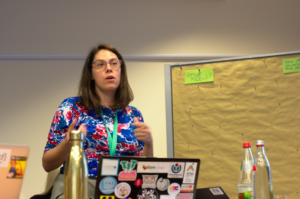
Mariana Fossati at the Berlin Wikimedia Conference, image by Habib M’henni, via Wikimedia Commons.
By the end of April, we participated in the Wikimedia Conference #WMCON in Berlin, Germany. We wanted to celebrate our first believers (our partners) and thank them face-to-face in public to show them our sincere gratitude. I thought: since it is an image campaign, why not use the great shots on Wikimedia Commons and print postcards as gifts? People loved the idea, and the postcards were awesome! Everyone was asking for more to take back home to their communities. You can access our online gallery (coming soon!) to check out these postcards.
Our communications team (Claudia and Kira) worked on the designs of the postcards and the professional social media coverage. Mariana and Siko presented about our work and shared more about the challenge across the conference. They brought back lots of positive vibes from Berlin, including photos and testimonies.
…Landing in Cape Town!
In July, 2018 we will be at Wikimania in Cape Town, and we are excited to meet you all. We will have more news and postcards to share!
What We Learned
Our online presence
When #VisibleWikiWomen launched, we had just redesigned the Whose Knowledge? website with our amazing development team, Design Action Collective. But we hadn’t established a strong social platform to announce the campaign – Whose Knowledge? was already using Twitter, but we needed to create new pages on Facebook, and Instagram. As the campaign developed, we began posting more frequently, but next year we will focus on promoting the campaign even more broadly early on. (Imagine how many more thousands of visible women there might be!)
Embracing cultural diversity
Most of our focus during #VisibleWikiWomen was on the global south, including Latin America and the Middle East. (I’m not biased but I know there’s lots of unleashed potential here!) And since the global south encompasses many different contexts, we had different responses from partners, and different understandings of the potential of the public domain. Open Foundation West Africa, for example, organized a great edit-a-thon (another one on the 5th of May), where they invited women who deserved to feature in Wikipedia articles to photograph themselves and participate in the edit-a-thon directly. The Latin American Wikimedians made huge contributions, both writing articles and uploading images. Tunisian Wikimedians provided wonderful photos of women. However, for me, the contributions also highlighted some differences in open source knowledge and awareness across the Middle East. For instance, there weren’t many available pictures in the public domain or easily accessible sources that could be openly licensed, unlike in many parts of Latin America, including Uruguay, Spain, and Mexico. We Arab Wikimedians have some work to do to raise this awareness!
Postcards not stories?
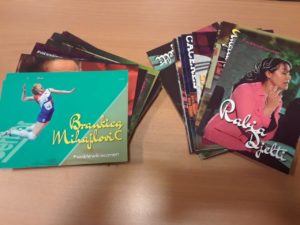
Our postcards portraying some of the amazing women of the #VisibleWikiWomen campaign
For the #VisibleWikiWomen Challenge, we decided to try having a story contest on social media that invited people to tell us the story of the woman behind the photo or illustration they uploaded, with details such as: why is this woman inspiring for you, why did you choose her, what do you like most about this picture? Unfortunately, no one applied for the story contest in the end! Perhaps we were trying to do too many things at once, but the lack of enthusiasm (or perhaps awareness) for the contest will be something we reflect on.
However, when we decided to turn a number of the #VisibleWikiWomen into high quality postcards, these were very positively received and seemed to generate a great deal of excitement and motivation in the Wikipedian community. Perhaps seeing these women in the public domain will inspire more people to tell their stories.
On to the Next Challenge
I have to say, it was a great journey: the idea, our partners, the support and love we have got, our #VisibleWikiWomen team. Weeks of hard work, inspiration, and passion! It was indeed successful, not only because there are now over 800 photos in the #VisibleWikiWomen Commons category, but also because the majority of the images can now be used to illustrate articles that lacked images before. We also learned that when partners across the Wikimedia movement come together to make women visible on Wikipedia and connect with new partners outside the movement, the impact is far greater than we might imagine! We look forward to next March and seeing the #VisibleWikiWomen Challenge grow over time. 🙂
But we are not done yet! Our challenge for this year ends with an online #VisibleWikiWomen edit-a-thon from 1-15 May. Join us to add more images of women to Wikipedia, Wikidata and more! You can start by registering in our dashboard to track the articles that have not yet been edited.
Share the call with your fellow wikipedians and happy editing!
Other stories in #VisibleWikiWomen
- Until Next Year: Farewell to our #VWW Campaign
- #VisibleWikiWomen: postcards of power and diversity
- Sharing Fuegia’s Memory
- The Life and Death of Marielle Franco on Wikipedia
- 3 ways cultural institutions can make women visible online
- Why I look for missing faces #VisibleWikiWomen
- Launching our #VisibleWikiWoman Challenge
